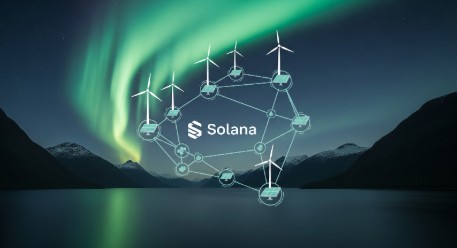The Nordic region has emerged as a global leader in sustainable blockchain adoption, with environmentally conscious cryptocurrencies gaining unprecedented traction. Among these green solutions, Solana price movements reflect growing investor confidence in sustainable blockchain technologies that align with the region’s ambitious climate goals. As Nordic countries continue their transition toward carbon neutrality, Solana’s energy-efficient architecture positions it as a cornerstone of the region’s digital transformation strategy.
Solana’s Environmental Leadership in Blockchain Technology
Solana has established itself as one of the most environmentally sustainable blockchain networks in the cryptocurrency ecosystem. Solana consumes 0.0023 TWh per year, a fraction of Bitcoin’s footprint due to its Proof-of-History + Proof-of-Stake design, making it an attractive option for environmentally conscious investors and institutions in the Nordic region.
The network’s energy efficiency is remarkable when compared to traditional blockchain systems. As of September 2024, the Solana network’s energy consumption in 2024 is projected to total 8,755 megawatt hours (MWh), about the same as the electricity used in 833 American homes, with an average energy usage per transaction of 0.00412 watt hours (Wh). This efficiency stems from Solana’s innovative consensus mechanism that combines Proof-of-Stake with Proof-of-History, creating a system that processes transactions with minimal environmental impact.
Carbon Neutral Initiatives and Environmental Impact
The Solana Foundation has made significant commitments to environmental responsibility. The Solana Foundation has pledged to keep the Solana network infrastructure carbon neutral through 2022 and beyond and will continue to show transparency with regular reports on energy usage. This commitment to transparency and environmental accountability resonates strongly with Nordic values of sustainability and corporate responsibility.
Recent data shows impressive progress in reducing the network’s carbon footprint. Solana stands out as an energy-efficient blockchain, reducing carbon emissions by 69% in 2024 with its PoS model and innovative proof-of-history mechanism. This substantial reduction demonstrates the network’s ability to scale while maintaining its environmental commitments, a crucial factor for Nordic institutions evaluating blockchain partnerships.
Nordic Region Embraces Sustainable Blockchain Solutions
The Nordic countries have positioned themselves at the forefront of sustainable cryptocurrency adoption. The Scandinavian countries have succeeded in turning the narrative around crypto on its head. It is no longer a threat to climate goals; it has become an ally in creating a greener and more efficient future. This shift in perspective has created fertile ground for environmentally conscious blockchain platforms like Solana to flourish.
Nordic crypto ownership increases from 1.5 million owners to 2.18 million, indicating growing acceptance and adoption of cryptocurrency technologies in the region. Nordic countries are experiencing a surge in adoption, with Norway leading the way. This expansion creates significant opportunities for sustainable blockchain solutions that align with the region’s environmental objectives.
The Nordic Blockchain Association plays a crucial role in promoting responsible blockchain adoption. The Nordic Blockchain Association’s mission is to drive the responsible and sustainable growth and use of ledger & blockchain technology, creating a supportive ecosystem for environmentally conscious blockchain projects like Solana.
SOL Price Resilience Through Sustainability
Solana’s commitment to environmental sustainability directly impacts its market positioning and price resilience. As global investors increasingly prioritize ESG (Environmental, Social, and Governance) criteria, cryptocurrencies with strong environmental profiles attract more institutional investment. Solana (SOL) is recognized as a popular carbon-neutral protocol offering lightning speeds, which enhances its appeal to both individual and institutional investors seeking sustainable investment options.
The network’s energy efficiency provides a competitive advantage that translates into market confidence. When traditional blockchain networks face criticism for their environmental impact, Solana’s sustainable approach positions it favorably for long-term adoption. This environmental advantage becomes particularly valuable in the Nordic market, where sustainability is not just preferred but often mandated by regulatory frameworks.
Technical Innovation Driving Green Solutions
Solana’s technical architecture represents a breakthrough in sustainable blockchain design. The energy consumed per transaction on the Solana network is significantly lower compared to traditional blockchains like Bitcoin and Ethereum, largely due to its unique Proof-of-History (PoH) mechanism, which complements its Proof-of-Stake (PoS) consensus.
The practical impact of this efficiency is substantial. A transaction on Solana takes less energy than two Google searches and 24 times less energy than charging your phone. This level of efficiency makes Solana particularly attractive for high-frequency applications and enterprise solutions in the Nordic region, where energy costs and environmental regulations are significant considerations.
Future Prospects for Green Blockchain in the Nordics
The convergence of Nordic environmental values with Solana’s sustainable technology creates promising opportunities for future growth. Solana is another leading name in the green cryptocurrency revolution in 2025, positioning itself as a key player in the sustainable blockchain ecosystem.
As Nordic countries continue to lead in renewable energy adoption and environmental innovation, the demand for sustainable blockchain solutions will likely increase. Solana’s proven track record of maintaining high performance while minimizing environmental impact makes it well-suited to capitalize on this trend.
The network’s ability to support complex decentralized applications while maintaining its green credentials provides a foundation for diverse use cases across industries. From sustainable finance to green supply chain management, Solana’s infrastructure can support the Nordic region’s transition to a more sustainable digital economy.
Conclusion
Solana’s role in powering sustainable blockchain solutions in the Nordic countries represents a significant opportunity for both environmental progress and financial innovation. The network’s exceptional energy efficiency, combined with strong commitments to carbon neutrality, aligns perfectly with Nordic values and regulatory frameworks. As cryptocurrency adoption continues to grow in the region, Solana’s sustainable approach provides a compelling value proposition that enhances price resilience and long-term investment potential.
The intersection of environmental responsibility and technological innovation positions Solana as a key enabler of the Nordic region’s digital transformation. With its proven ability to deliver high performance while minimizing environmental impact, Solana stands ready to support the next phase of sustainable blockchain adoption across Scandinavia and beyond. This alignment of values and technology creates a strong foundation for continued growth and market confidence in SOL’s long-term prospects.










